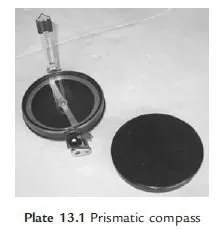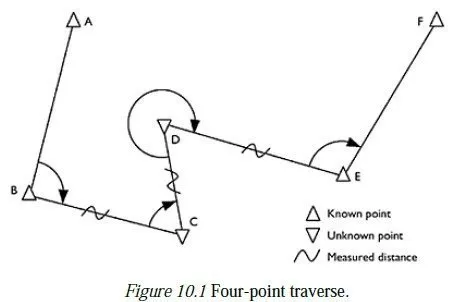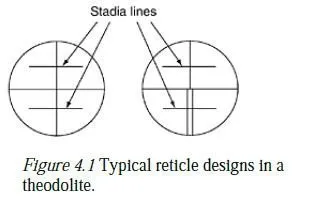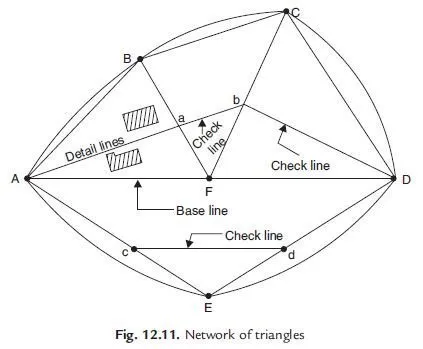The types of compass that are used commonly are: (i) prismatic compass; and (ii) surveyor compass.
The essential parts of both type are:
(i) a magnetic needle,
(ii) a graduated circle,
(iii) a line of sight, and
(iv) a box to house them.
There are some differences in the essential parts of the two type of compass. The construction of the two types of compass is explained and the difference in them is pointed out in this article.
Prismatic Compass
Figure 13.1 shows the cross-section of a typical prismatic compass [see plate 13.1 also].
A magnetic needle of broad form (1) is balanced on a hard and pointed steel pivot (2). The top of the pointed pivot is protected with agate cap (3).
An aluminium graduated disk (4) is fixed to the top of the needle. The graduations are from zero to 360° in clockwise direction when read from top. The direction of north is treated as zero degrees, east as 90°, south as 180° and west as 270°. However, while taking the readings observations are at the other end of line of sight. Hence, the readings are shifted by 180° and graduations are marked as shown in Fig. 13.2. The graduations are marked inverted because they are read through a prism.
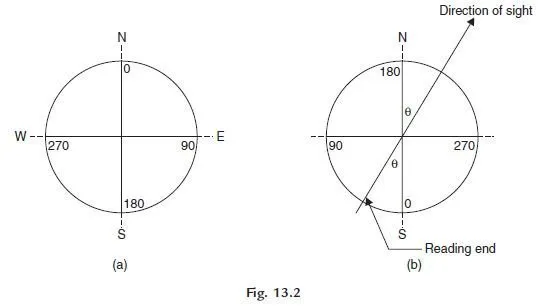
The line of sight consists of object unit and the reading unit. Object unit consists of a slit metal
frame (5) hinged to the box. In the centre the slit is provided with a horse hair or a fine wire or thread
(6). The metal frame is provided with a hinged mirror (7), which can be placed upward or downward on
the frame. It can be slided along the frame. The mirror can be adjusted to view objects too high or too
low from the position of compass. Reading unit is provided at diametrically opposite edge. It consists of
a prism (8) with a sighting eye vane (9). The prism magnifies the readings on the graduation disk just
below it. For focussing, the prism is lowered or raised on the frame carrying it and then fixed with the
stud (10). Dark sunglasses (11) provided near the line of sight can be interposed if the object to be
sighted is bright (e.g., sun).
The bottom of the box (12) which is about 85 mm to 110 mm supports the pivot of needle firmly
at its centre. The object vane and the prism are supported on the sides of the box. The box is provided
with a glass (13) lid which protects the graduation disc at the same time permit the direct reading from
the top. When the object vane is folded on the glass top it presses a lifting pin (14) which activates
lifting lever (15) lifts the needle off the pivot. Thus, it prevents undue wear of pivot point. While taking
reading, if graduation disc vibrates, it can be dampened with a spring (16). For pressing spring a knob
or brake pin (17) is provided on the box. When not in use prism can be folded over the edge of the box.
The box is provided with a lid to close it when the compass is not in use. The box is provided with a
socket to fit it on the top of a tripod.
Surveyors Compass
In this type of compass graduation disc is fixed to the box and magnetic needle is free to rotate above it.
There is no prism provided at viewing end, but has a narrow slit. After fixing the line of sight, the reading is directly taken from the top of the glass cover. Hence, graduations are written directly (not inverted). In this compass graduations are from zero to 90°, zero being to north or south and 90° being to east and west. An angle of 20° to north direction to the east is written as N 20° E, and an angle of 40° to east from south is written as S 40° E. Always first direction indicated is north or south and the last letter indicates east or west direction. In this system graduated circle rotates with line of sight and magnetic needle is always towards north. The reading is taken at the tip of needle. Hence, on the compass east and west are marked interchanged and marked [Ref. Fig. 13.3] Plate 13.2 shows the photograph of a surveyors compass.
Difference Between Prismatic Compass and Surveyors Compass
The difference between prismatic and surveyors compass are listed in Table 13.1.

